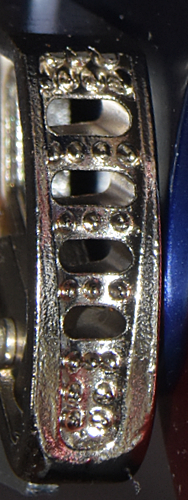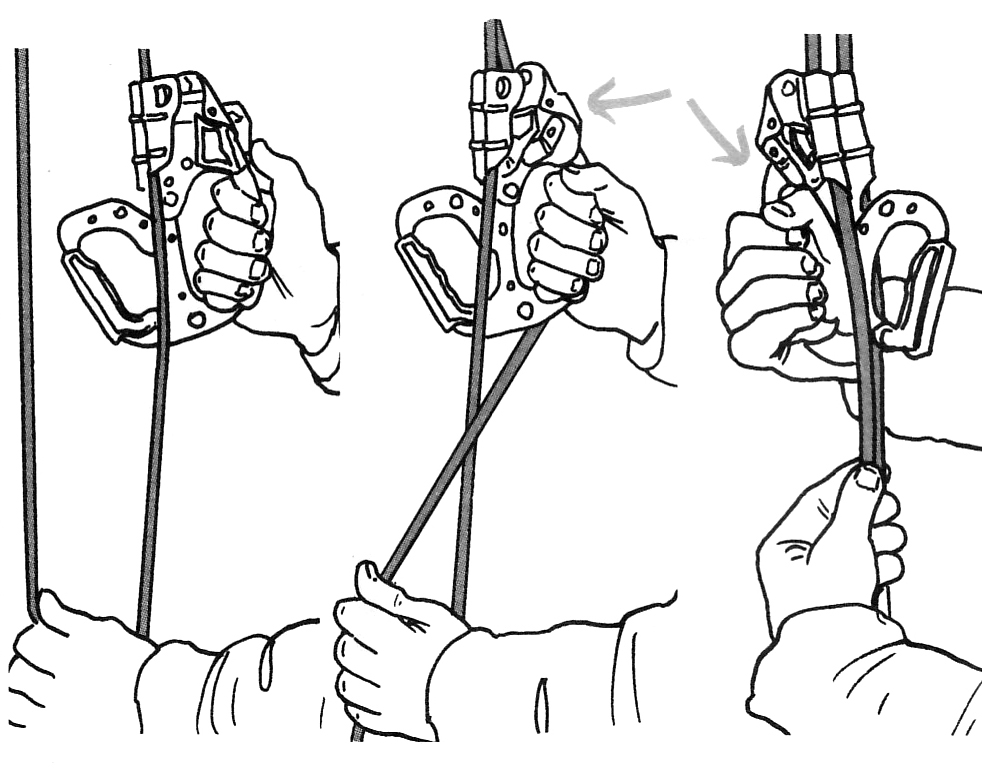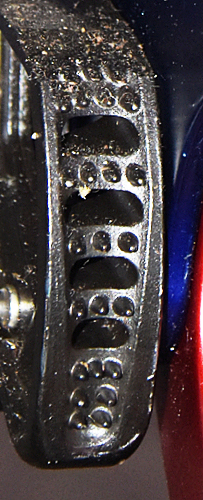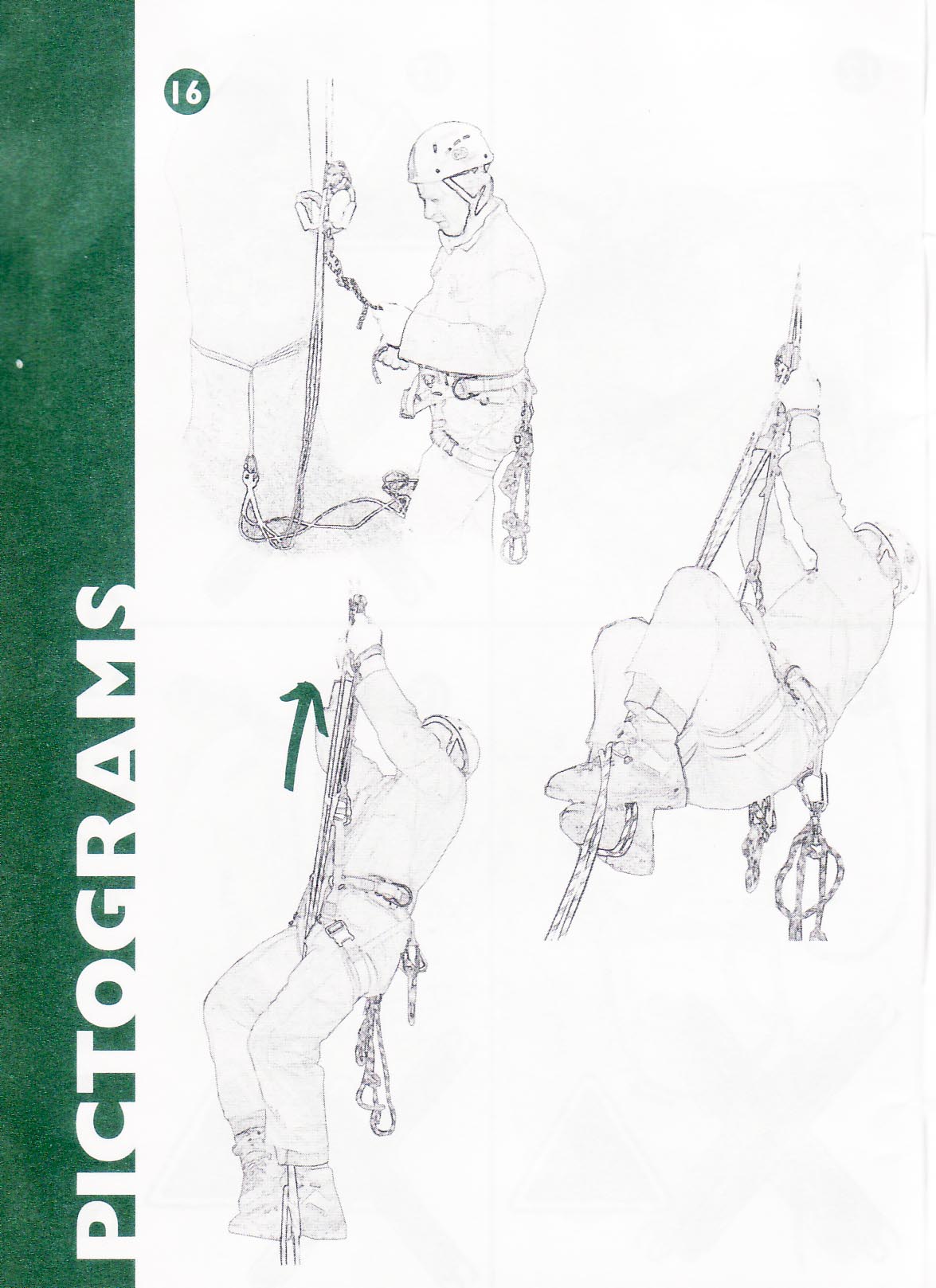Overview
[ Top
| Version B
| Version C
| Return to H.E.C. Ascenders
]
Version A
(#1529, 2292)
Technical Details
 I acquired my Kong Twin, Version A new on eBay from Simon Holmes in 2009. I acquired another in 2017 as part of Bob Thrun’s collection.
I acquired my Kong Twin, Version A new on eBay from Simon Holmes in 2009. I acquired another in 2017 as part of Bob Thrun’s collection.
This Kong Twin is 207 mm. tall, 166 mm. wide, 50 mm. thick, and weighs 468 g.
Version A has phosphorescent handles and a different cam safety than Version C. Instead of the bent tab, Version A has an 8.8 mm. tall, 7 mm. diameter thumb post riveted to the safety.
The front side of the caver handle is screened with the Kong logo, "Italy," "Bonaiti" in underlined script, "CE 0426, "EN 567, "05122 04," the UIAA logo, "F-15087," a rigging icon, and ø 8-13 mm." One side of each handle has "KONG-BONAITI-ITALY" molded into it, and the other side has the molded word "PHOSPHORESCENT."
Phosphorescent handles are nice but unnecessary, and I've had problems with them disintegrating over time.

[ Top
| Version A
| Version C
| Return to H.E.C. Ascenders
]
Version B
(#3496)
 Technical Details
Technical Details
I acquired my Kong Twin, Version B on eBay from John C. Raaf in 2021.
Version B is 208 mm. tall, 166 mm. wide, 50 mm. thick, and weighs 467 g.
Version B is the same as Version C except that it has the plated cam and pin safety of Version A instead of the painted cam and tab safety.
The front side of the caver handle is printed with the Kong logo, "Italy," an underlined "Bonaiti" signature, "CE 0426," "EN 567," "01290 04", the UIAA logo, an icon showing the ascender rigged on a single rope with a dashed arrow pointing up, and "ø 8-13 mm." The front side of the climber hand grip and the rear side of the caver hand grip have "BONAITI - KONG - ITALY" in raised letters.
This is my choice among the versions on this page, for two reasons. First, and most important, I've had problems with the phosphorescent handles on some of my Kong ascenders degrading with time, but have not seen the same issues with the black plastic handles. Second, I prefer the pin safety to the tab safety. THis is purely a personal preference, but it just feels better in my hands, and my thumb does not tend to slide off of it as easily.
[ Top
| Version A
| Version C
| Return to H.E.C. Ascenders
]
Version C
(#210, 2290)
Technical Details
I acquired one pair of these ascenders from WesSpur Tree Equipment
in February 2007. I acquired another in 2017 as part of Bob Thrun’s collection.
The Kong Twin is a derivative of the discontinued Kong
Modular ascender, with four pieces riveted together:
two modular ascender assemblies,
a climber handle, and a caver handle. The ascenders are mounted
back to back, with the climber handle between. The smaller caver
handle attaches to the climber handle.
The ascender assemblies
 The front ascender assembly is right-handed and the rear ascender
assembly is left-handed. Each shell is a tall irregular shaped
stamping made from 3.4 mm. anodized aluminum alloy sheet
metal that is later anodized. A rope channel is formed in of
one side and a smaller cam channel lies opposite the first. A
hole drilled through both sides of the cam channel accepts a
5 mm. rivet. The cam and cam spring are mounted on this
rivet, along with a flat washer on the inner side of the cam.
A 14.2 by 17.4 mm. oval hole through both sides of the rope
channel provide an attachment point just above the cam. There
is a punched cam stop above the cam, and a 12.5 mm. wide,
10.5 mm.high D-shaped hole above the cam stop.
There is a 12.7 mm.hole punched at the base of each ascender
assembly shell, but it is blocked by the climber handle. Two
rivets above this hole help hold the two ascender assemblies
and climber handle together. There is another 9 mm. hole
below the cam channel. This holds a semi-tubular rivet that also helps
hold the two ascender assemblies and climber handle together.
The front ascender assembly is right-handed and the rear ascender
assembly is left-handed. Each shell is a tall irregular shaped
stamping made from 3.4 mm. anodized aluminum alloy sheet
metal that is later anodized. A rope channel is formed in of
one side and a smaller cam channel lies opposite the first. A
hole drilled through both sides of the cam channel accepts a
5 mm. rivet. The cam and cam spring are mounted on this
rivet, along with a flat washer on the inner side of the cam.
A 14.2 by 17.4 mm. oval hole through both sides of the rope
channel provide an attachment point just above the cam. There
is a punched cam stop above the cam, and a 12.5 mm. wide,
10.5 mm.high D-shaped hole above the cam stop.
There is a 12.7 mm.hole punched at the base of each ascender
assembly shell, but it is blocked by the climber handle. Two
rivets above this hole help hold the two ascender assemblies
and climber handle together. There is another 9 mm. hole
below the cam channel. This holds a semi-tubular rivet that also helps
hold the two ascender assemblies and climber handle together.
The cam is a painted steel casting. The cam has number of
small conical teeth, all of which have their axes approximately
parallel to the upper cam surface. The tooth pattern is (3)(4.H)^2(3.H)^2(3.3.2)
where H is an oval hole. Like the other ascenders, the inner
cam face radius reduces from top to bottom to accommodate various
sized ropes. A spring-loaded manual safety bar is mounted on
the bottom of the cam with a small semi-tubular rivet. The normal action
of the spring holds the safety against the cam. When the cam
is opened, the shell interferes with the safety bar, thus preventing
opening the cam. If the safety bar is moved away from the cam
(opposing the spring), it will clear the shell and the cam will
open. At full open the safety can be released and the spring
will hold the safety against the back of the shell. This provides
a means of locking the cam open. A tab on the safety bar assists
in operating the safety mechanism.
There are no makings on the ascender assemblies.
Climber handle
The climber handle attaches between the two ascender assemblies
by the rivets mentioned earlier. The climber handle is made from
3.6 mm. anodized aluminum alloy. There are no reinforcing
ribs. The handle has a 107 mm. by 49 mm. oval hand
opening. A black plastic hand grip is molded to the sheet metal
frame. The handgrip has four shallow, closely spaced finger grooves.
A 13.5 mm. attachment hole near the bottom of the handle
aligns with a similar hole on the caver handle.
The front side of the hand grip has "BONAITI - KONG -
ITALY" in raised letters.
Caver handle
The caver handle attaches to the side of the climber handle
by two rivets. It is made from 3.6 mm. anodized aluminum
alloy. There are no reinforcing ribs. The handle has a 85 mm
by 46 mm. irregular hand opening. A black plastic hand grip
is molded to the sheet metal frame. The handgrip has four shallow,
closely spaced finger grooves. A 13.5 mm. attachment hole
near the bottom of the handle aligns with a similar hole on the
caver handle.
The front side of the caver handle is printed with the Kong logo, the Reading-Is-Dangerous icon, "CE 0426," "EN 567," "058826 05 0072," the UIAA logo, an icon showing the ascender rigged on a single rope with a dashed arrow pointing up, and "ø 8-13 mm." The rear side of the hand grip has "BONAITI - KONG - ITALY" in raised letters.
 The Twin is a well-made ascender. All sharp edges have been
removed. The attachment points are simply holes in the shell, and
although rounded they should have been beveled more; even so,
I would consider their small radius too sharp for directly attaching
sling ropes, but the double thickness created by the two handles
helps. They are probably acceptably rounded for webbing (or could
be made so), but considering the proximity of the attachment points
to the main rope, I would recommend using a small maillon for
most attachments in order to reduce the risk of sling abrasion.
The Twin is a well-made ascender. All sharp edges have been
removed. The attachment points are simply holes in the shell, and
although rounded they should have been beveled more; even so,
I would consider their small radius too sharp for directly attaching
sling ropes, but the double thickness created by the two handles
helps. They are probably acceptably rounded for webbing (or could
be made so), but considering the proximity of the attachment points
to the main rope, I would recommend using a small maillon for
most attachments in order to reduce the risk of sling abrasion.
The upper rope attachment hole is located very close to the
main rope. Anything placed through the upper attachment hole will
probably drag on the main line. Most carabiners won't fit through
the holes: they are too small to reach through both ascender assemblies
and too large to make the bend at just one
The front ascender safety is easy to use with the right hand,
but the rear one is not. The ribbed handle is not comfortable
for me because the ribs are spaced poorly for my hand. In addition,
the handle is too square. A file can eliminate both objections.
What is it good for? I don't see the Kong Twin being used by
mainstream cavers or climbers. It was designed for the
arborist community, and I'm not a Tarzan, so it would not be right
for me to discuss their techniques. Maybe the arborists will discuss
the twin on one of their web sites.
The instructions state:
Use the Twin Ascender only for climbing on double ropes of the same diameter. Important: ropes must be fastened to avoid accidental and dangerous slippage. Attention: descent is very dangerous.
[ Top
| Version A
| Version B
| Version C
| Return to H.E.C. Ascenders
]




